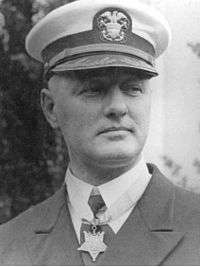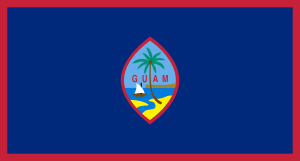Willis W. Bradley
| Willis Winter Bradley, Jr. | |
|---|---|
  Commander Willis W. Bradley, photographed during the 1920s, wearing the Medal of Honor | |
| Born |
June 28, 1884 Ransomville, New York |
| Died |
August 27, 1954 (aged 70) Santa Barbara, California |
| Place of burial |
Fort Rosecrans National Cemetery, San Diego, California |
| Allegiance | United States of America |
| Service/branch | United States Navy |
| Years of service | 1906–1946 |
| Rank | Captain |
| Unit | USS Pittsburgh |
| Battles/wars |
World War I World War II |
| Awards | Medal of Honor |
| Relations | Bruce McCandless (son-in-law) |
| Other work | politician |
Willis Winter Bradley Jr. (June 28, 1884 – August 27, 1954) was a Naval officer, a recipient of the Medal of Honor and a U.S. Representative from California.
Biography
Born in Ransomville, New York, Bradley moved with his parents to Milnor, North Dakota, in July 1884 and to Forman, North Dakota, in 1891. He attended the public schools, and Hamline University, St. Paul, Minnesota. He served as the deputy registrant of deeds of Sargent County, North Dakota in 1902 and 1903.
He graduated from the United States Naval Academy on September 12, 1906 and went to sea in USS Virginia (BB-13). After two years at sea as a passed midshipman, he received his commission as an ensign on September 13, 1908. Successively, Bradley served in USS Culgoa (AF-3) from the fall of 1908 to October 1910, helped to fit out and commission USS Perkins (DD-26) (Torpedo Boat Destroyer No. 26), and served in her until March 1911. From then until September 1912, he saw duty, first in the transport USS Hancock and then in USS South Carolina. Next, he commanded USS Biddle (TB-26) (Torpedo Boat No. 26) and the Reserve Torpedo Group at Annapolis, Md.
Beginning in September 1913, Bradley studied ordnance and explosives at the Naval Postgraduate School in Annapolis, Maryland, and then at George Washington University in Washington, D.C. He continued his studies at the Naval Proving Ground in Indian Head, Maryland, at Bausch & Lomb, and at the Midvale Steel Co. in Pittsburgh, Pa. In July 1915, Bradley returned to sea in command of USS Stewart. That December, he was transferred to command of USS Hull and of the Reserve Torpedo Division, Pacific Fleet.
After service in USS San Diego between September 1916 and February 1917, Bradley became gunnery officer on the USS Pittsburgh. In that capacity, he received the Medal of Honor (World War I) for his actions on July 23, 1917 during a powder explosion in one of the ship's casemates. Though temporarily stunned, he entered the compartment, saved a man's life, and then reentered the casemate to extinguish burning gunpowder.
Bradley moved ashore again in January 1918 to head the Explosives, Fuses, and Primers Section of the Bureau of Ordnance. From there, he went to the Naval Torpedo Station in Keyport, Washington, in August 1919 to serve as a naval inspector. Returning to sea in June 1920, Bradley served as gunnery officer in USS Texas (BB-35) until May 1921. At that time, he reported to the Mare Island Navy Yard to assist in fitting out and commissioning USS California (BB-44). After the battleship went into commission on August 10, he served as her gunnery officer.
Bradley returned to Keyport in May 1922 for two years of duty at the Naval Torpedo Station as the Naval Inspector in Charge. From July 1924 to November 1926, he commanded USS Gold Star (AK-12), the station ship at Guam in the Mariana Islands. Between late 1926 and the middle of 1929, Bradley served in the Naval Reserve Section in the Bureau of Navigation. Following that tour of duty, he became Governor of Guam in June 1929. As Governor, he issued Guam's first Bill of Rights, sought United States citizenship for the Chamorros and proclaimed them to be citizens of Guam, and reorganized the Guam Congress. He also made possible the first free elections of village commissioners. He was considered a Progressive Republican and civil libertarian.
On April 8, 1930 he created the only official government run local post called "Guam Guard Mail". It used overprinted Philippine stamps for the 1st, 3rd, and 4th issues and a locally printed one for the 2nd. It was needed since the U.S. Post Office did not deliver the mail to individual homes or businesses. "Guam Guard Mail" lasted one year forcing the Post Office to take over the operation on the northern half of Guam on January 1, 1931 and the southern half on April 9, 1931.
Bradley resumed sea duty in July 1931 in command of USS Bridge (AF-1). Two years later, he became Captain of the Yard at the Pearl Harbor Navy Yard. After six months, however, he was transferred to command of USS Portland (CA-33).
That assignment lasted until June 1937 at which time he was reassigned to the Naval War College as a student. After a year of duty with the Pacific coast section of the Board of Inspection and Survey beginning in May 1938, Capt. Bradley commanded Destroyer Squadron (DesRon) 31, Battle Force, based in San Diego for a year. At the conclusion of that assignment, he resumed duty with the Board of Inspection and Survey on the west coast. He continued in that billet through the end of World War II and until his retirement on August 1, 1946.
Bradley was elected as a Republican to the Eightieth Congress (January 3, 1947 – January 3, 1949). He served as assistant to the president of the Pacific Coast Steamship Co. from 1949 to 1952. He served as member of the California State Assembly from 1952 until his death.[1]
Bradley died in Santa Barbara, California, August 27, 1954. He was interred in Fort Rosecrans National Cemetery, San Diego, California. The USS Bradley (FF-1041), was named in his honor.
Medal of Honor citation
Rank and organization: Commander, U.S. Navy. Born: 28 June 1884, Ransomville, N.Y. Appointed from: North Dakota. Citation:
For extraordinary heroism and devotion to duty while serving on the U.S.S. Pittsburgh, at the time of an accidental explosion of ammunition on that vessel. On 23 July 1917, some saluting cartridge cases were being reloaded in the after casemate: through an accident an explosion occurred. Comdr. Bradley (then Lieutenant), who was about to enter the casemate, was blown back by the explosion and rendered momentarily unconscious, but while still dazed, crawled into the casemate to extinguish burning materials in dangerous proximity to a considerable amount of powder, thus preventing further explosions.
Namesakes
USS Bradley (FF-1041) was named in his honor.
See also
Notes
References
- This article incorporates text from the public domain Dictionary of American Naval Fighting Ships.
- United States Congress. "Willis W. Bradley (id: B000750)". Biographical Directory of the United States Congress. Retrieved on February 23, 2008
| United States House of Representatives | ||
|---|---|---|
| Preceded by Clyde Doyle |
Member of the U.S. House of Representatives from California's 18th congressional district 1947–1949 |
Succeeded by Clyde Doyle |
| Military offices | ||
| Preceded by Lloyd Stowell Shapley |
Naval Governor of Guam 1929–1931 |
Succeeded by Edmund Root |
![]() This article incorporates public domain material from the Biographical Directory of the United States Congress website http://bioguide.congress.gov.
This article incorporates public domain material from the Biographical Directory of the United States Congress website http://bioguide.congress.gov.
